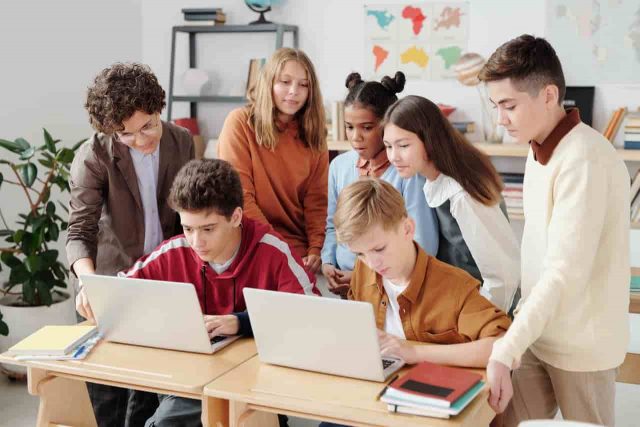Table of Contents
Strategies To Create A Personalized Learning Environment
Each student has their own unique learning styles, strengths and weaknesses, and academic history that shapes who they are and how they learn. This learner variability exists in every classroom across the globe, yet education systems typically ask for a streamlined approach that disregards this variability. Student-centered classrooms utilizing personalized learning provide students with an opportunity to engage in learning in a way that is best suited for them and honors their uniqueness.
Personalized learning classrooms offer students the opportunity to have autonomy and ownership in their learning. Thus, enabling students to develop competency in self-awareness and self-management as they learn to master course content in their own time.
Teachers transform from the “sage on the stage” role to both the “guide on the side” and the “lead learner”, helping students make informed decisions about their learning and facilitating a variety of lessons and activities to support student learning.
Student-centered personalized learning classrooms are carefully orchestrated controlled chaos, which require systems in place to support both teachers and students in maximizing the effectiveness of the learning process.
Establishing Goals
Having clear goals that are both teacher and student created is the first step to personalizing the classroom. Teachers often form goals based on their knowledge of content area standards, 21st century skills, and the social-emotional development of their students.
Students in turn create their own goals about what and how they will learn best in the environment. Common goal setting strategies for students include SMART Goals and WOOP goals, both of which are frameworks that help support students in specifying their desired outcomes and creating a plan to get there.
Assessing Variability
The next step is to learn about the individual needs of students in your classroom. For content purposes, this often involves creating pre-assessments for the skills your students need to master throughout the unit/year. These pre-assessments are most useful when they pull through.
Aside from content, teachers need to have an understanding of their students as individuals. Through the creation of Learner Profiles, students can communicate their learning styles, preferences and ways in which they best access, engage and express themselves in the classroom. Teachers are then called to use this information to design the learning environment and learning experiences for their students.
Designing Universally
A personalized learning classroom functions best when it is universally designed. This means that every student has the opportunity to use whatever resources are necessary and available to support their learning. This is in contrast to differentiated learning, where students are given specific items to support their learning.
Universally designed classrooms provide all students all items needed and students can select what will best support their learning, thus supporting the personalized learning environment. Students are able to personalize their learning experiences through expressing voice and choice within the learning environment in the ways in which they are accessing, engaging, and expressing knowledge.
As students are able to personalize their experiences, they are also able to move at their own pace as teachers help support individuals as they work through their zone of proximal development. Self-pacing provides additional freedom and chance for students to express autonomy in their learning. This also requires systems and structures set in place by the teacher to ensure students are working to achieve their learning goals.
Personalized Learning in Action
Contrary to popular belief, personalized learning does not completely remove or completely overwhelm a teacher. My students are not simply sitting down with technology and moving independently through their work. Nor am I individually constructing a learning experience for every student in my classroom.
Rather, I’ve structured my class in a way that provides students the opportunity to personalize their experience themselves. Utilizing blended-instruction, project-based learning and mastery-based assessment, I’ve enabled students to develop a strong sense of ownership in their learning.
- Establishing Goals: Utilizing a competency-based approach, I design learning goals for my students to master each of the key learning goals within a competency. I also support my students in setting their own learning goals to grow in both their confidence and competence in the content area with student-teacher conferencing.
- Assessing Variability: At the beginning of each new unit/project, I provide my students with a pre-assessment to determine their academic readiness to approach the learning targets. These pre-assessments are built utilizing foundational skills from 6-8 along with grade-level specific skills so I can determine how to best differentiate my support of students throughout the learning process. My students also complete learner profiles to share their individual learning identities with me. Another popular way I’ve seen this done is through well constructed student inventories.
- Designing Universally: My classroom model is centered around project-based learning and ensuring that my students see that math is more than just solving for x. I provide my students with a variety of experiences to learn from and practice with their content knowledge as they work to build their mastery of the competency learning goals. I utilize the Modern Classrooms framework for blended learning, self-pacing and mastery-based assessment in order to support and structure the project-based learning process for my students.
Pursuing Personalized Learning in Your Classroom
Personalized learning will help teachers to address the natural learner variability that is present in our classrooms every day. Just as personalized learning is individualized for the student, the process of developing a personalized learning classroom is individualized for the teacher. Teachers should reflect on their own teaching practices and expertise to determine the best methods for establishing goals, assessing student variability and designing learning experiences for their students. Thus creating their own personalized, personalized-learning classroom.

